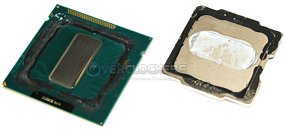Wednesday, April 25th 2012

Ivy Bridge Temperatures Could Be Linked To TIM Inside Integrated Heatspreader: Report
PC enthusiasts with Ivy Bridge engineering samples, and reviewers at large have come to the consensus that Ivy Bridge is a slightly warmer chip than it should be. An investigation by Overclockers.com revealed a possible contributing factor to that. Upon carefully removing the integrated heatspreader (IHS) of an Ivy Bridge Core processor (that nickel-plated copper plate on top of the processor which makes contact with the cooler), the investigator found common thermal paste between the CPU die and the IHS, and along the sides of the die.
In comparison, Intel used flux-less solder to bind the IHS to the die on previous-generation Sandy Bridge Core processors in the LGA1155 package. Attempting to remove IHS off a chip with flux-less solder won't end well, as it could rip the die off the package. On the other hand, the idea behind use of flux-less solder in CPU packages is to improve heat transfer between the die and the IHS. Using thermal paste to do the job results in slightly inferior heat transfer, but removing IHS is safer. One can be sure that making it safe for IHS removal couldn't have been the issue behind switching back to conventional thermal paste, as everything under the IHS isn't user-serviceable anyway, and off limits for them. Perhaps Intel kept extreme overclockers in mind.
Source:
Overclockers.com
In comparison, Intel used flux-less solder to bind the IHS to the die on previous-generation Sandy Bridge Core processors in the LGA1155 package. Attempting to remove IHS off a chip with flux-less solder won't end well, as it could rip the die off the package. On the other hand, the idea behind use of flux-less solder in CPU packages is to improve heat transfer between the die and the IHS. Using thermal paste to do the job results in slightly inferior heat transfer, but removing IHS is safer. One can be sure that making it safe for IHS removal couldn't have been the issue behind switching back to conventional thermal paste, as everything under the IHS isn't user-serviceable anyway, and off limits for them. Perhaps Intel kept extreme overclockers in mind.

97 Comments on Ivy Bridge Temperatures Could Be Linked To TIM Inside Integrated Heatspreader: Report
Someone change the TIM into a solder and give it a shot?
They did it so cooler manufacturers, their partners, can sell new coolers, designed to deal with this new "heat problem".
:rolleyes:
You'll see these new coolers in the coming months and at Computex. :laugh:
I hope a few notice the die orientation in reference to the PCB, and note how the CPU sits in the socket, and that they align heat-pipe-based coolers in the right direction.
;)
Pretty sure the extreme guys already know this anyway. Power consumed + CPU temps + pot temps = problems with IHS contact. Why do you think it was tried in the first place?:laugh:
IF anything, Intel made sure to have a socket clamp design that is easily removed so that extreme guys don't have clearance issues with de-lidded CPUs and the retention mechanism.;)
"The first answer is correct, but wrong at the same time – power density is greater, but it isn’t what is causing temperatures to be as much as 20 °C higher on Ivy Bridge compared to Sandy Bridge when overclocked."
OMFG WUT????
Note that the Overclockers article explains that the difference in thermal conductivity between solder and TIM is absolutely huge:
Solder: 80 W/mK
POS TIM: 5 W/mK
Along with the marginal instructions per clock improvement (and almost zero gaming benefit) and now this, I'm glad that I bought my 2700K last November and have no desire to replace it anytime soon. If I were buying a laptop though, getting IB would be a no-brainer.
At least maybe the 2700k could be cheaper now.
Annnd i don't think its because they are ES, i could get behind that if there were previous accounts of ES having TIM
my money is on them all being TIM though.
Unfortunately, this issue means that the 2700K will stay UP in price, not come down, since savvy enthusiasts will prefer this to IB. I now really don't want to overdrive mine too hard, to ensure that it has a long service life.
If they removed the IHS and assumed this was the reason behind the higher temps why didnt they just put it back in and confirm it?
Anyway i guess it could be because these are ES.
Also, everybody is talking about waiting for another stepping, but I'm not sure much can be done here, considering the 22nm tri-gate process itself is an inherent obstacle.
Didn't help with the OC, but that thing ran like that for 2 years.